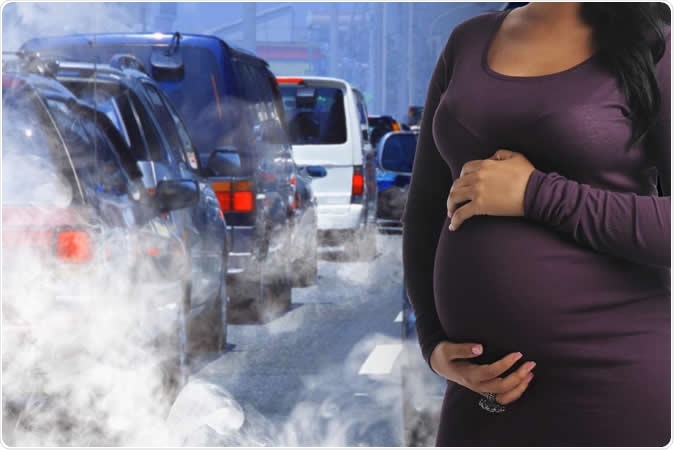A new report published by the National Toxicology Program (NTP) indicates that air pollution derived from traffic could make a pregnant woman more likely to develop hypertension than otherwise. The study is based on an analysis of the association between traffic-related air pollution, or TRAP, with hypertensive disorders of pregnancy.

A new report from the National Toxicology Program (NTP) suggests that traffic-related air pollution increases a pregnant woman's risk for dangerous increases in blood pressure, known as hypertension. Image Credit: NIEHS
Traffic and air pollution
The pollutants classified as TRAP are mostly due to the burning of fossil fuels (diesel, petroleum and natural or petroleum gas) by automobiles. Since TRAP contains both solids and liquids in an inhalable mix, it can easily cause ill-health. It is also a recognized risk factor for hypertension and other cardiovascular diseases.
Traffic releases a number of pollutant particles into the air, among which particulate matter (PM) is an important component. PM refers to a complex mix of solid and liquid particles and droplets suspended in the air.
Fine particulate matter, especially that with a diameter 2.5 micrometers or less (PM2.5), is capable of making its way into the lungs. PM2.5 particles are so tiny, in fact, that it would take 30 of the largest of them to meet the diameter of a single human hair, at 70 micrometers.
Pregnancy hypertension
More than 1 in 10 pregnancies are complicated by hypertension, all over the world. This condition is a major cause of poor outcomes and illness for both the mother and the baby, including death. Some of these hypertension-related poor outcomes include preterm delivery, low birth weight, and chronic medical conditions in the child due to the premature birth.
There are a variety of conditions that are classified under the umbrella term “hypertensive disorders of pregnancy”. They vary in the time at which they occur, but the symptoms and related complications are often similar.
The four primary types of hypertensive disorder in pregnancy are:
- Gestational hypertension or high blood pressure occurring after the first half of pregnancy is completed.
- Preeclampsia, a condition in which hypertension sets in during the second half of pregnancy but is accompanied by the presence of protein in urine, and deranged liver or kidney function. The most serious and often fatal complication of preeclampsia is eclampsia, when the mother develops seizures.
- Chronic hypertension when the woman is already hypertensive before pregnancy, or is diagnosed with high blood pressure early in pregnancy, and continues to have this condition throughout her pregnancy.
- Chronic hypertension with preeclampsia, in which high blood pressure existing before pregnancy or found to exist in the early part of pregnancy, persists throughout gestation and new features like protein appearing in urine, or abnormal kidney or liver function tests, also occur.
The study
Previously, many pediatricians had asked the NTP to look into air pollution with respect to children’s health. The subsequent review of literature by the NTP showed that TRAP was associated with pregnancy hypertension. The study was actually motivated by this observation.
The link between being exposed to traffic exhaust and related emissions containing PM2.5 and the occurrence of high blood pressure in pregnancy is established. Researcher Brandy Beverly says, “When these women are exposed to PM2.5 during their entire pregnancy, the likelihood of developing preeclampsia increases by about 50%."
The NTP also looked at nitrogen oxides, soot carbon, elemental carbon and carbon monoxide in TRAP. In addition, it measured the traffic density and how close these pregnant women lived to the larger roads. This was because it is suggested by earlier work that living within a quarter-mile of a major road or in an area that has plenty of traffic during pregnancy increases the risk of pregnancy hypertension.
The findings
The NTP evaluated the evidence from its own four-level human hazard scale of assessment of TRAP’s individual constituents. This scale ranks substances from “known”, through “presumed”, “suspected” and “not classifiable” as a human hazard.
The researchers found that TRAP is “a presumed human hazard for hypertensive disorders during pregnancy.” Academics and industrial experts agreed as one to the conclusion. However, which of the four classes of pregnancy hypertension is impacted by TRAP exposure remains an open question. More study will be needed to elucidate the specific effects of TRAP on blood pressure in pregnant women.